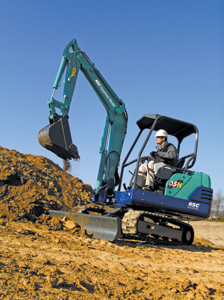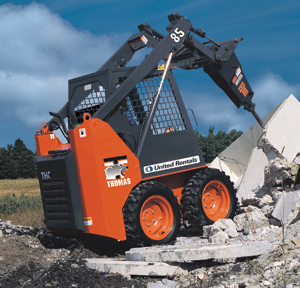Budget Rentals

 The rental industry has often been described as “recession-proof,” but as with any business connected to construction, 2008 has been an unusual year. Depending on location and inventory mix, some rental companies have grown while others have contracted. For example, general tool rental companies focused on supplying equipment to those in the homebuilding industry have seen difficult times, but some of those businesses are starting to see more customers renting needed tools for remodeling jobs or repairing foreclosed homes.
The rental industry has often been described as “recession-proof,” but as with any business connected to construction, 2008 has been an unusual year. Depending on location and inventory mix, some rental companies have grown while others have contracted. For example, general tool rental companies focused on supplying equipment to those in the homebuilding industry have seen difficult times, but some of those businesses are starting to see more customers renting needed tools for remodeling jobs or repairing foreclosed homes.
 Rental companies that target contractors specializing in non-residential construction and infrastructure projects have had a pretty good 2008, but almost all expect a softer marketplace in 2009. The rental industry, however, has proven to be resilient, often outperforming expectations in economically challenging times. If one segment of the construction industry is down, rental businesses are generally able to shift emphasis to equipment for other segments that might be growing.
Rental companies that target contractors specializing in non-residential construction and infrastructure projects have had a pretty good 2008, but almost all expect a softer marketplace in 2009. The rental industry, however, has proven to be resilient, often outperforming expectations in economically challenging times. If one segment of the construction industry is down, rental businesses are generally able to shift emphasis to equipment for other segments that might be growing.
Also, in the current economy and tight credit markets, more contractors and do-it-yourselfers may need to rent instead of buying machines.
“The American Rental Association [ARA] will continue to promote the rental concept aggressively in 2009,” said Christine Wehrman, ARA’s executive vice president and CEO. “Think about it. When customers are more pressured due to the economy, renting equipment is the logical solution. There are opportunities to market the rental concept for both a short- and long-term benefit to rental businesses.”
To better understand the economic drivers of the rental industry and the impact the industry has in North America, the ARA and the association’s Rental Management magazine commissioned Global Insight, one of the world’s leading economic research firms. Since then, Global Insight has produced two comprehensive State of the Equipment Rental Industry reports for 2006 and 2007. The 2008 report is scheduled to be published in February.
According to the 2007 State of the Equipment Rental Industry report, the construction and industrial equipment sector accounted for $25.5 billion in U.S. rental revenue while general tool rental revenues were $8.5 billion. Overall in 2008, Global Insight is projecting a modest decline in both construction and industrial equipment and general tool rental revenue. The research company expects similar results in 2009, mostly because of a weaker U.S. economic outlook for the year.
However, the expected results for 2008 are now better than originally forecasted by Global Insight because of the rental industry’s ability to change focus and meet customer demands. Another factor was the strong pace of nonresidential construction during the first three quarters of 2008, benefiting the rental industry and helping support continued rental demand for aerial equipment in particular.
Non-residential construction slowed in the fourth quarter 2008 and is expected to stall in 2009. As a result, many rental companies are not buying new aerial equipment to expand inventory, and manufacturers of this type of equipment slowed or temporarily halted production at the end of 2008.
“I think the North American rental industry follows what happens in non-residential construction, which follows housing starts with an 18-month lag. There will not be many new jobs and 2009 will be difficult, but everything is cyclical,” said Dan Kaplan, a rental industry consultant and founder of Daniel Kaplan Associates in Morristown, N.J. Kaplan was previously the president of Hertz Equipment Rental Corp. from 1982 to 1997.
Kaplan expects the current cycle for the construction and rental industries to break out in mid-2009, leading to a “decent” 2010.

Instead of expanding fleets, many rental companies are more focused on greater time use of existing fleets to maintain or increase rental revenue. As work has slowed for construction companies, many are selling used equipment, but at prices far below what machines were commanding at auction a year ago. Should infrastructure projects and other government spending yield new work, some construction companies might just decide to rent rather than own equipment as a more cost-efficient solution. The result could be greater rental penetration in the construction market.
“Since 1993, there has been a movement from ownership to rental,” Kaplan said. “In 1993, rental penetration was about 5 percent. Today, it’s closer to 40 percent and, by 2012, it will be at 50 percent. This movement will continue. In times like these, there’s also more incentive to rent than own equipment.”
Some of the national rental chains also say this type of trend is a possibility for 2009. “Over the next year, we expect to see an acceleration of the secular shift toward renting and away from owning equipment, especially if credit continues to remain an issue. Our customers who in the past purchased a piece of equipment may now be more likely to rent. This is particularly true in the current downturn, where customers are not only cash-strapped, but also find it difficult to finance capital purchases,” said Michael Kneeland, CEO of United Rentals, during a third-quarter conference call with investors in late October.
United Rentals closed 31 branches in early 2008 and expected to close another 30 branches before the end of the year, selling off about 20 percent of the affected fleet and repurposing about 80 percent. The company also touted its ability to move fleets from depressed areas to regions where there is more demand for the equipment as an advantage. “It’s a very effective device that no other [equivalent] company can employ on the same scale. Fleet transfers are one of the key reasons where our utilization stayed constant at 68 percent in the third quarter,” Kneeland said.
What this all means for rental rates, however, is unclear. Many national chains and independents are trying to keep rates steady at a time when business costs continue to rise.
Hertz Equipment Rental Corp., as part of a corporate-wide plan including car and truck rentals, increased short-term equipment rental rates by about 10 percent and long-term rates by 5 percent in late October, although negotiated contract rates were not affected by the increase.
United Rentals, in the current economic environment, expects rates to be down about 2.5 percent for the year overall, but says a significant portion of that decrease in rates comes from depressed construction markets in California and Florida.
“We’re seeing good discipline out there. Obviously there are regional areas where we do bump into things, but if you want to quantify it for a national level, we’re not seeing anything that is dramatic. I think that the industry overall is being very responsive,” Kneeland said.
RSC closed or consolidated 19 locations in the third quarter 2008, but also opened 14 locations in areas with strong growth opportunities. “It has been a wild ride in the financial market and in the global economy over the last several weeks, the impact of which is still unfolding,” said Erik Olsson, CEO of RSC, during the company’s third-quarter conference call with investors in late November.

Overall, Olsson said market demand for rental equipment varied across geographies with Texas, Midwest, Gulf Coast and Canada continuing to show “healthy demands albeit at the moderating rate,” while housing-related markets like Florida, California and Arizona are down sharply.
In the construction and industrial equipment segment, some of the more popular rental equipment includes skid steers, mini excavators, aerial work platforms, backhoes and telehandlers. Most general tool rental companies list yard-care equipment, jackhammers, walk-behind trenchers, concrete saws and compactors among the most popular and profitable pieces of equipment they rent.
Kaplan said likely strong equipment categories for rental in 2009 will be pumps and power generation. “This is an emerging area for rental that wasn’t followed in the past,” he said.
He also said there are “strengths in all equipment categories in all areas. For Fort McMurray in Canada, core rental equipment is all strong, but if you are a rental company in Atlanta, Miami or Phoenix, then it could be a different story.”
Wayne Walley is the editor of Rental Management magazine, based in Moline, Ill.





Comments are closed here.